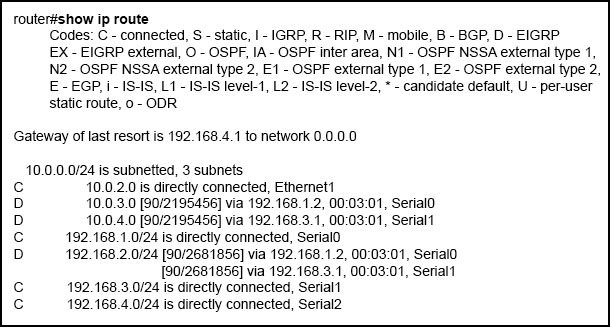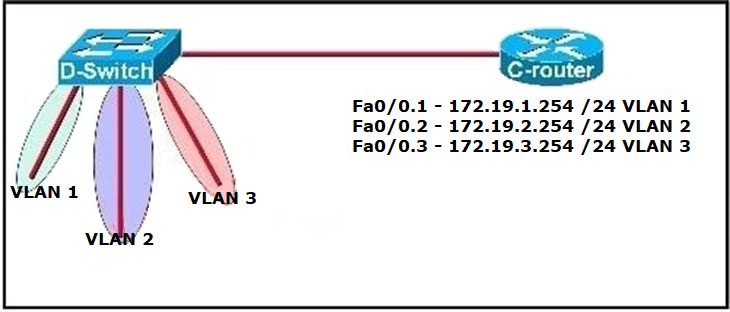Refer to the exhibit. If RTR01 is configured as shown, which three addresses will be received by other routers that are running EIGRP on the network? (Choose three.)
ACD
Which configuration command can you apply to a HSRP router so that its local interface becomes active if all other routers in the group fail?
A
Simply because that will be the default behavior routers would follow in the event all other routers in the HSRP group fail, then it would not keep attributes such as priority or preemption. What preemption does in summary is to make sure that the configured Priority on all routers within the same HSRP group is always respected. That is, if R1 is configured on the HSRP group with a priority of 150 but he stands as active since all other routers currently subscribed to that group have a priority 150, then will router will preempt the current active router and will take over hence becoming the new active router.
With preemption disabled, the new router does not preempt the current active router, unless routers in the group have to renegotiate their roles based on each router's priority at the time of negotiation.
Which two statements about eBGP neighbor relationships are true? (Choose two.)
AB
Refer to the exhibit. How will the router handle a packet destined for 192.0.2.156?
C
Which statements describe the routing protocol OSPF? (Choose three.)
ACE
The OSPF protocol is based on link-state technology, which is a departure from the Bellman-Ford vector based algorithms used in traditional Internet routing protocols such as RIP. OSPF has introduced new concepts such as authentication of routing updates, Variable Length Subnet Masks (VLSM), route summarization, and so forth.
OSPF uses flooding to exchange link-state updates between routers. Any change in routing information is flooded to all routers in the network. Areas are introduced to put a boundary on the explosion of link-state updates. Flooding and calculation of the Dijkstra algorithm on a router is limited to changes within an area.
Refer to the exhibit. After you apply the given configurations to R1 and R2 you notice that OSPFv3 fails to start.
A
Which command is used to display the collection of OSPF link states?
D
The "show ip ospf database" command displays the link states. Here is an example:
Here is the lsa database on R2.
R2#show ip ospf database -
OSPF Router with ID (2.2.2.2) (Process ID 1)
Router Link States (Area 0)
Link ID ADV Router Age Seq# Checksum Link count2.2.2.2 2.2.2.2 793 0x80000003 0x004F85 210.4.4.4 10.4.4.4 776 0x80000004 0x005643 1111.111.111.111
111.111.111.111 755 0x80000005 0x0059CA 2133.133.133.133 133.133.133.133 775 0x80000005 0x00B5B1 2 Net Link States (Area 0)
Link ID ADV Router Age Seq# Checksum10.1.1.1 111.111.111.111 794 0x80000001 0x001E8B10.2.2.3 133.133.133.133 812 0x80000001 0x004BA910.4.4.1
111.111.111.111 755 0x80000001 0x007F1610.4.4.3 133.133.133.133 775 0x80000001 0x00C31F
Refer to the exhibit. A network associate has configured OSPF with the command:
City(config-router)# network 192.168.12.64 0.0.0.63 area 0
After completing the configuration, the associate discovers that not all the interfaces are participating in OSPF. Which three of the interfaces shown in the exhibit will participate in OSPF according to this configuration statement? (Choose three.)
BCD
The "network 192.168.12.64 0.0.0.63 equals to network 192.168.12.64/26. This network has:
✑ Increment: 64 (/26= 1111 1111.1111 1111.1111 1111.1100 0000) + Network address:
192.168.12.64
✑ Broadcast address: 192.168.12.127
Therefore all interface in the range of this network will join OSPF.
Refer to the exhibit. C-router is to be used as a "router-on-a-stick" to route between the VLANs. All the interfaces have been properly configured and IP routing is operational. The hosts in the VLANs have been configured with the appropriate default gateway. What is true about this configuration?
D
Since all the same router (C-router) is the default gateway for all three VLANs, all traffic destined to a different VLA will be sent to the C-router. The C-router will have knowledge of all three networks since they will appear as directly connected in the routing table. Since the C-router already knows how to get to all three networks, no routing protocols need to be configured.
Refer to the exhibit. Which address and mask combination represents a summary of the routes learned by EIGRP?
C
The binary version of 20 is 10100.
The binary version of 16 is 10000.
The binary version of 24 is 11000.
The binary version of 28 is 11100.
The subnet mask is /28. The mask is 255.255.255.240.
Note:
From the output above, EIGRP learned 4 routes and we need to find out the summary of them:
✑ 192.168.25.16
192.168.25.20
✑ 192.168.25.24
✑ 192.168.25.28
-> The increment should be 28 ?16 = 12 but 12 is not an exponentiation of 2; so we must choose 16 (24). Therefore the subnet mask is /28 (=1111 1111.1111
1111.1111 1111.11110000) = 255.255.255.240.
So the best answer should be 192.168.25.16 255.255.255.240.